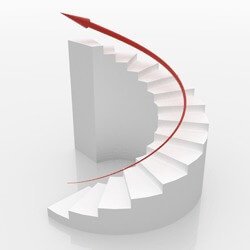Why is it so difficult to set effective profit and stop loss targets?
The problem originates with the assumption that the markets never change, and of course that is a bad assumption. The markets are constantly changing, expanding and contracting. Just understanding that the markets are in constant flux will better equip you to take advantage of what it is giving (or not giving) and allow you to set effective profit and stop loss targets.
How do you do that? The first thing you need to consider is the market’s Average Daily Range. Notice that the Average Daily Range is not the same as the Average True Range, which is a measure of market volatility. Just as the name implies, Average Daily Range is an average range the market makes each day. Why is this important? Well, if we have an idea of how many ticks the market is likely to move in a day we can judge how far the market has already come and how far it is likely to go, relative to the average.
Of course you can make your own calculations for determining the Average Daily Range, or use software to quickly calculate the Average Daily Range for you. A trading tool such as the Day Ranger can quickly figure out the Average Daily Range and how many ticks the market has made for the day. It can show you the 5, 10 and 30 day Average Daily Ranges in a compact viewing chart.
Knowing how the market is trading compared to the averages allows you to make better assumptions of what to expect for the current trading day.
For example, if the 5 day average is higher than the 10, and the 10 is higher than the 30, that would suggest that the market is expanding and as such we might expect the current session to be very active, maybe even expanding the range even further. Conversely, if the 5, 10 and 30 day averages are diminishing relative to each other then we can assume the market is contracting and the current session might be limited in range and maybe even become choppy or range bound.
But how can we use this information for optimizing our profit and stop loss targets?
Knowing if the market is expanding, contracting or staying the same gives us an idea if the market is getting more or less volatile or trading “normally”. If the market is contracting and slowing down, then we will want to be more conservative with both our profit and stop loss targets. If the market is expanding and becoming for volatile then the opposite is true and we need more aggressive profit and stop loss targets. If the market is trading within the normal range parameters, then we can choose something in-between.
A simple way to pick your targets for a slow moving market is to take the Average Daily Range and divide it by 5. This means you are looking to use 1/5th of the daily range for your targets – a fairly conservative objective. If the market is expanding and becoming more volatile divide the Average Daily Range by 3, or 1/3rd of the daily range, for your profit and stop loss targets. In a normal market, divide the Average Daily Range by 4, which will give you a quarter of the Average Daily Range as a target. You may need to refine these targets for the markets you are trading, but it is a good guide to start with.
Generally speaking I tend to use the same target ranges for both my profit and stop loss orders. People always ask me about Risk/Reward Ratios (RRR) and why I don’t reduce the risk amount to reflect a 2:1 or 3:1 reward to risk ratio. I’ve addressed this in another article, but the reason is simple: Risk/Reward Ratios don’t work.
While they seem to make sense on the surface RRR’s don’t work when put into practice. Why? Because NO ONE knows where the market is going next, so why would you base a trade decision on something you don’t know; namely the reward side of the equation? The Risk side of the equation the only part you have any control over, so that’s where your attention needs to be.
Moreover, the Risk only comes into play IF the market hits your stop loss order. So long as your target is hit before the stop loss, does it really matter if you’re running a 1/2:1, 1:1, 2:1 or 3:1 trade? Don’t strangle your trade with an overly tight stop loss and don’t leave money on the table with an overly tight profit target. By considering the market’s Average Daily Range you can have the best of both and capitalize on your winners while minimizing your losers.
Come see how we use the Average Daily Range in our Trade Room. Click HERE to Register.
